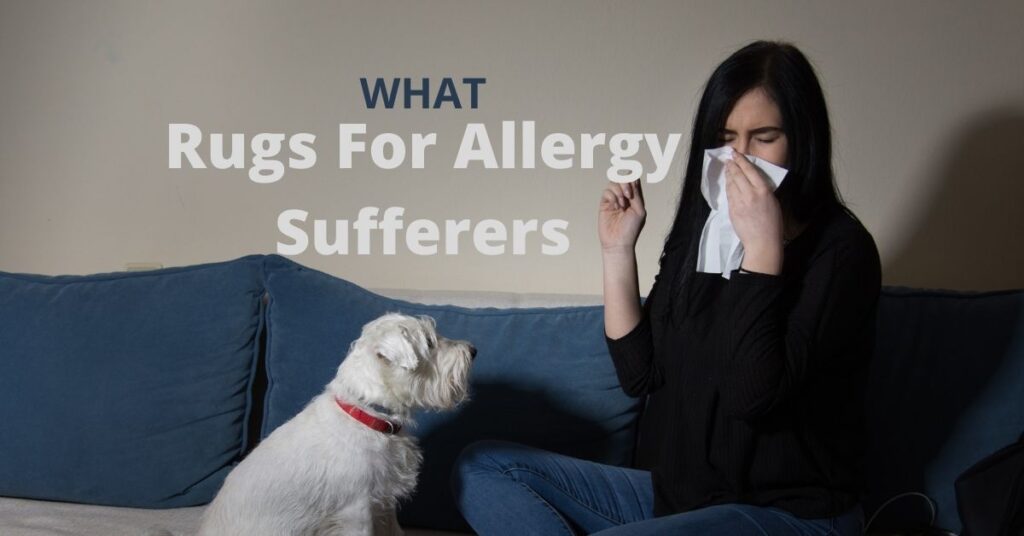
Table of Contents
Best Area Rugs For Allergy Sufferers | Hypoallergenic Rugs
Best Area Rugs For Allergy Sufferers
It would be annoying if you come to know that even your favorite carpet can be allergic. Isn’t it!. Do not worry; We stand behind you because we have included allergens here and how you can prevent them. In a while, you will also learn how hypoallergenic rugs can benefit allergy sufferers.
What Causes Of Allergens In Carpets?
Before proceeding directly to the remedy, it is necessary and prudent to know the factors that create the allergens.
PETS
You certainly love your pets like family, but they can be harmful as they spread dander on your carpet, which can make your skin allergies worse. The flakes of dead skin and the hair of your dogs and cats can accumulate on your carpet. The situation gets worse if your dog’s/cat’s dander is associated with outdoor soil and pollen.
WETNESS & MOLD GROWTH
Another cause of allergen to your rug to consider is the wet area and growth of mold. Moist places in your house may instigate the growth of mold. The problem continues with the spread of the mold when you ignore removing it. To prevent humidity from building up, we recommend ensuring good air circulation. When you wash your carpet, do not forget to let it dry thoroughly to prevent mold from forming.
OUTDOOR OBJECTS
Of all other factors, one of the ways that allergens come to your rug is from foreign objects, but this is accidental. What does that mean! It is common for family members who enter to bring foreign objects attached to their clothing, shoes, or whatever they are wearing. Carpets can help to collect and store them and thus reduce the spread of allergens.
Also See
Hypoallergenic rugs for dogs.
Hypoallergenic rugs nursery.
What Are The Best Rug For Asthma Sufferers And Allergies Suffers
- Synthetic Materials – Choose synthetic material rugs like polypropylene, nylon, polyester; they are affordable, easy to clean, very durable.
- Rugs Having Low Piles – Rugs with low piles attract less dirt, and it’s easier to wash and dry them. Low pile area rugs are recommended, especially for the front doors or the entryways.
- Go Green – Natural fibers like cotton, hemp, jute, seagrass, and sisal are eco-friendly, and they all pass the allergen test. Since they have no pile height, are tightly woven, and have minimal shedding, there is no chance of allergic reactions.
- Low VOC – Before buying a rug, an allergic sufferer must make sure the rug’s material has a low Volatile Organic Compound (VOC). A label of VOC determines how much air pollutant or toxin the material will emit as it gets older.
- Vacuuming & Wash Rugs – Carpets need good maintenance to keep their good looks and keep them healthy. Especially allergy sufferers must keep their rugs clean by vacuuming regularly and washing them when required. For better maintenance, choose machine-washable rugs that are small in size.
How To Get Rid Of Carpet Allergies - Carpet Allergy Solutions
So how to get rid of new carpet allergies! Below are some carpet allergy solutions you can follow:
Cleanliness – First Things First
First, begin with following the most basic steps. Keep your surroundings neat, hygienic. You must know what’s good and bad for your indoor rug.
FiRugs always recommends vacuuming your rug frequently(at least twice a week, depending on the type of rug’s material). If you are very sensitive to dust particles, you may want to outsource this cleaning task to someone else.
Note: Do wear a mask to avoid inhaling any harmful particles coming out from the rug.
If you’ve settled on a daily carpet vacuum, now is the time to find out exactly how you should go about it. You must know how to handle your vacuum on rugs in the correct way. Follow the back and forth approach while vacuuming your carpet fibers. Doing so will keep the fibers straight while you clean them thoroughly.
The correct frequency is essential. Many homeowners get into the misconception that their carpet is in the area with little or no traffic, so they don’t need to clean it frequently. Assuming this is the wrong approach. Surrounding dust particles are constantly accumulating deep within the fiber of your carpet, and you need to take care of them if you want to keep your carpet free of dirt and dust.
The quality standards of your vacuum cleaner are paramount because the life of your carpet and the health of your family members depend on it and the quality cleaning you do. Experts strongly recommend opting for built-in HEPA filters, as they are more effective for smaller particles like pollen and therefore reduce the risk of allergies. The brush’s bristles will be soft and offer good suction.
Best Rugs For Dust Mite Allergies | Best Area Rugs For Allergy Sufferers
While there are some people who are allergic to new rugs, some are allergic to wool rugs alone. So what are the anti allergy carpets that an allergic person needs to consider while buying a rug?
Below are fibers that make excellent rugs and also reduces allergens and improves indoor air quality as according to The Carpet and Rug Institute’s Green Label.
Polypropylene
Polypropylene, the synthetic rugs are the best options for allergy sufferers. Polypropylene is such that they remove dust bugs and contaminants. The polypropylene rugs and nylon rugs mostly have low piles and used outdoors as well.
Wool
Since the wool material is too dry for the dust mites that thrive in humid and hot environments, the bugs cannot eat them. No doubt wool made rugs are superior rugs in the rugs industry for the plenty of benefits they have. They are dust-resistant, stain resistant, environment friendly, and easy washable rugs.
Sisal
Within the natural fibers, one is the sisal. Sisal rugs have benefits that jute may lack. A good quality sisal rug when woven tightly would shed very little.
Jute
When talking about jute, one of the frequently asked questions is “are jute rugs good for allergies“? Well, fiber rugs are not only durable and affordable rugs, but after cotton, they are the second widely used fibers for rug making. The fiber is thin yet robust. They put away dust mites, shed very little and do release microscopic materials in the air.
